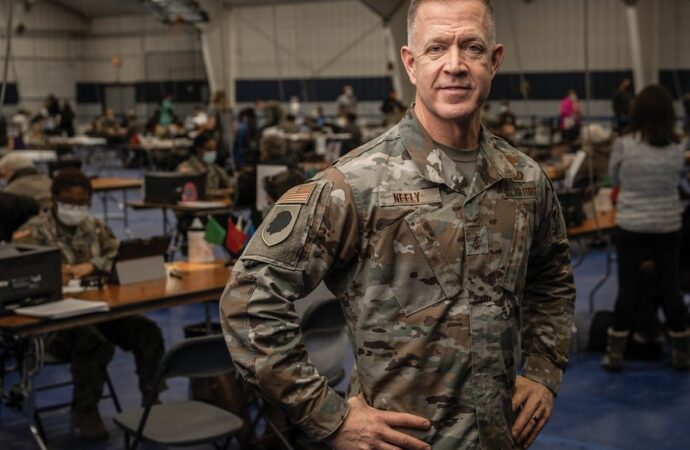A long, strange year for the Illinois National Guard is culminating in one of its longest and strangest domestic deployments: injecting vaccines into hundreds of thousands of arms. “There is no comparison” to this year, says Maj. Gen. Richard Neely, the adjutant general of the state of Illinois, director of the Illinois Department of Military
A long, strange year for the Illinois National Guard is culminating in one of its longest and strangest domestic deployments: injecting vaccines into hundreds of thousands of arms.
“There is no comparison” to this year, says Maj. Gen. Richard Neely, the adjutant general of the state of Illinois, director of the Illinois Department of Military Affairs and commander of both the Illinois Army and Air National Guard. In addition to the current vaccination campaign, the guard helped stand up large-scale testing sites, support mortuary operations in Cook County and deliver isolation pods for use at the McCormick Place alternate care facility. In between, guard members were deployed on flood and wildfire duty, responded to civil unrest in Chicago and flew to Washington, D.C., to protect the U.S. Capitol from insurrectionists.
Roughly a month into the mission, more than 1,000 service members were helping with the state’s COVID-19 vaccination effort, with authorization to call up another thousand. They staff 15 mass vaccination sites, assist local health departments and serve on mobile teams that will be deployed to communities with limited health care options, state prisons and independent-living facilities.
Guard members have already administered more than 150,000 doses, and their current pace is 11,000 doses per day. Early on, they were delivering 11 percent of all of the state’s shots.
The number of deployed service members and mass vaccination sites will only grow in the weeks to come. The effort takes close coordination between the state’s Department of Public Health, Emergency Management Agency and local health departments.
Activation
The federal activation of 47,000 National Guard personnel across the country to respond to the pandemic was the second-largest nationwide peacetime domestic activation after Hurricane Katrina in 2005, says Paul Grasmehr, reference coordinator at the Pritzker Military Museum & Library. Illinois guard officials compare the scale of this mission to the response to the Great Flood of 1993—when 7,000 members were activated—and the deployment of the 2,600-member 33rd Infantry Brigade to Afghanistan in 2009.
“What we are very well trained to do is take the concept of a wicked problem and breaking it down,” says Col. Seth Hible, an operations officer whose full-time job is teaching at Lake Park High School in Roselle. Floods, storms and war-zone deployments are well-worn sections of the National Guard playbook. But there was no script for a pandemic like this one.
In the fall, Neely told his team to think through the likely challenges of a mass vaccination program. “At that point IDPH hadn’t asked for help, but we knew the vaccine was coming. It was going to be a large lift for any state.”
By the time Gov. J.B. Pritzker called in January, the guard had a plan. “Two days later, we briefed senior staff, and four days later we briefed the governor,” Neely recalls.
They would use 18-member military vaccination teams, or MVATs. Six members are medical personnel trained to give shots. The other 12 are support staffers who handle everything from crowd and traffic control to security, records input and registration, taking temperatures, observing people after they’ve received shots, or shuttling supplies and paperwork.
The guard has 52 MVATs today. The first 25 were “organic,” Neely says, or all National Guard members. The rest are a mix of guard and contracted medical personnel to administer shots.
Early snags involved fusing military, medical and emergency management lingo, state and guard officials say. Having worked together on testing sites and having team members embedded in each other’s offices helped. Hible likened the collaboration to his work with State and Defense epartment officials in Afghanistan.
“IEMA, for the most part, is looking longer term to try and figure out how the guard will be relieved from this mission in about two or three months or however long it takes. IDPH is looking for the shorter term, where to target our specific vaccination teams, and then we become the force generator that produces those teams and pushes them to the field,” Hible says. Local health departments give the teams their marching orders.
The state’s first mass vaccination site opened Jan. 26 at the Tinley Park Convention Center. It came together in roughly a week, says Cook County Health’s Ratna Kanumury, who is heading up vaccination coordination.
“It was rapid fire,” Kanumury says. “We did a site survey on Saturday (Jan. 16). By that Thursday, the contract was finalized. We had supplies delivered Friday evening, and we were unpacking boxes on Saturday,” setting up IT, testing walkie-talkies and working with pharmacy partners to ensure vaccine storage was adequate.
Staffing
The guard is fully staffing the Tinley Park site with eight MVAT teams, supervised by Cook County Health. At full capacity, the site can vaccinate 3,500 people every day. Guard members are also helping at the county’s vaccination sites at Triton and South Suburban colleges and at several CCH clinics. The only difficulty has been training new staff as guard members complete their tours and others replace them. Officials have opted to have some overlap so new members can learn from those on the way out.
In Winnebago County, the guard is working alongside a volunteer medical reserve corps and public health workers at a vaccination site at Sandy Hollow, and it is rolling out mobile vaccination units going to workplaces to vaccinate teachers, grocery store clerks, transit drivers and workers in factories and food-processing plants.
“We’d been experiencing very high rates of infection and high rates of morbidity, mortality,” plus a lengthy mitigation shutdown, says Dr. Sandra Martell, Winnebago’s public health administrator. “We knew we had to pick up the pace.”
Having civilians work alongside uniformed guard members helped alleviate any concerns by those skeptical or scared of having the military involved in the effort, she says. Plus, guard members bring a lot from their civilian life; some know different languages or IT workarounds, for example. Others are familiar faces from the local community.
Who picks up the tab? While governors control service members, the federal Department of Defense will pay until at least March 31. So far, the state has spent $2.4 million for medical staffing, supplies and equipment. “We are expecting that this could cost as much as $100 million,” IEMA Deputy Director Scott Swinford says, which will be fully reimbursed. “We appreciate the federal government’s assistance monetarily and getting us through this.”



























Leave a Comment
Your email address will not be published. Required fields are marked with *